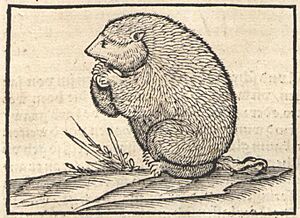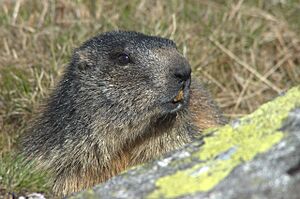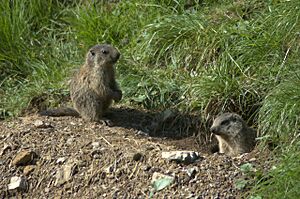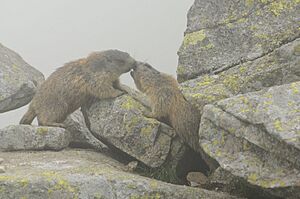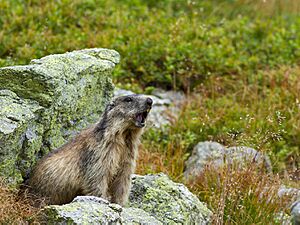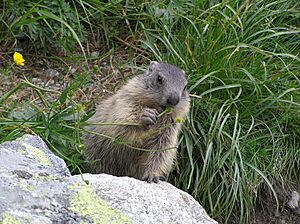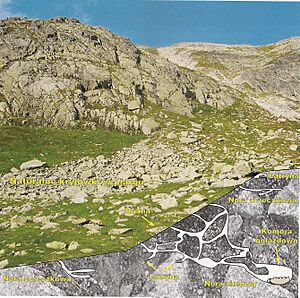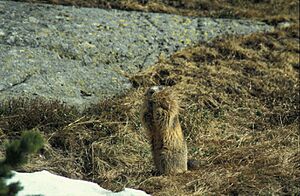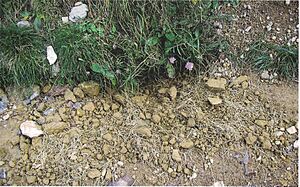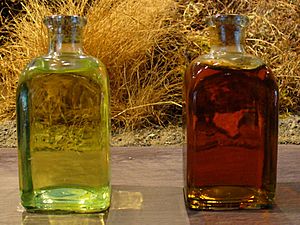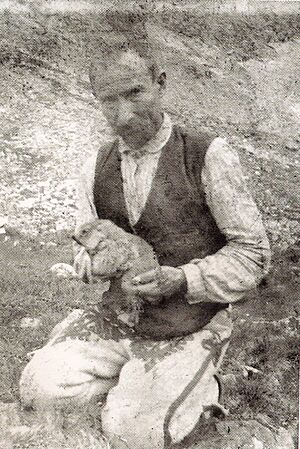Tatra marmot facts for kids
Quick facts for kids Marmota marmota latirostris |
|
|---|---|
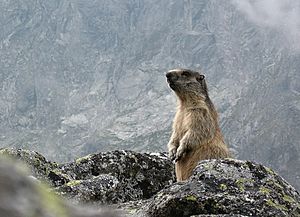 |
|
| Scientific classification |
|
| Kingdom: | Animalia |
| Phylum: | Chordata |
| Class: | Mammalia |
| Order: | Rodentia |
| Family: | Sciuridae |
| Genus: | Marmota |
| Species: | |
| Subspecies: |
M. m. latirostris
|
| Trinomial name | |
| Marmota marmota latirostris Kratochvíl, 1961
|
|
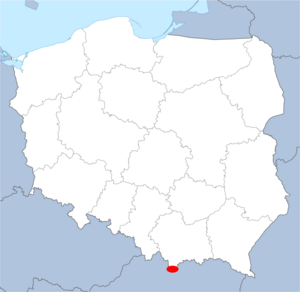 |
|
| Distribution of Marmota marmota latirostris | |
The Tatra marmot (Marmota marmota latirostris) is a special type of marmot found only in the Tatra Mountains. It's a subspecies of the larger marmot family. Long ago, people hunted these marmots, but by the 1800s, their numbers dropped a lot.
Tatra marmots eat plants and are active in the summer. They live in family groups in the mountains, from the higher forest areas to the very top, rocky parts. This marmot is one of the rarest vertebrates in Poland and is now strictly protected by law in both Poland and Slovakia. It is listed as a "strongly endangered subspecies" in Poland and "critically endangered" in the Polish Carpathians. Scientists are still learning a lot about this unique animal.
Contents
Discovering the Tatra Marmot
People in Poland started to know more about marmots as settlements slowly grew in the Tatra Mountains. In 1255, a special permission was given to hunt in the forests up to the Tatras. Over time, a group of hunters became known for hunting marmots. They were called "whistlers" because of the marmots' alarm calls.
Early writings about Tatra marmots mostly focused on their hunting value. In 1774, a pastor named Andreas Jonas Czirbesz wrote that Carpathian marmots lived in high mountain dens. He noted they ate roots and herbs, and had tasty, fatty meat. People valued their meat, skins, and especially their fat, which was used in old folk medicine.
Marmots were hunted freely until around 1868 in Poland and 1883 in Hungary. After these dates, rules were put in place to protect them.
In 1865, Maksymilian Nowicki wrote the first detailed description of marmot biology. He was a pioneer in nature conservation in Poland. He called marmots "little bear mice" because of their appearance. He also described how marmots dig long burrows, line them with moss and grass, and then hibernate for the winter. They store food and get very fat before sleeping, waking up thin in the spring.
How Tatra Marmots Fit In
Marmots belong to the family of squirrels. The species Marmota marmota lived in Europe a long time ago, during the Pleistocene ice age. As the climate got warmer, marmots moved to cooler mountain areas. They ended up living mainly in the Alps and the Tatra Mountains.
The marmots in the Alps and Tatras became separated about 15,000 to 50,000 years ago. For a long time, people thought they were the same. But in the late 1950s, scientists from Czechoslovakia studied them closely.
In 1961, zoologist Josef Kratochvíl studied a Tatra marmot. He found important differences in its nasal bones compared to Alpine marmots. Tatra marmots have a wider and longer front part of the nasal bone. They are also a bit smaller and have slightly different fur colors. Because of these differences, Kratochvíl named the Tatra marmot a separate subspecies: M. marmota latirostris. Alpine marmots are now called M. marmota marmota. Some scientists still wonder if these differences are big enough, but genetic studies are needed to be sure.
What's in a Name?
The name Marmota might come from old languages meaning "murmuring" or "purring." It could also mean "mountain mouse" in Latin. The subspecies name latirostris comes from two Latin words: lātus meaning "wide," and rōstrum meaning "nose" or "beak." So, latirostris means "broad-nosed," referring to the wider nasal bone of the Tatra marmot.
What Tatra Marmots Look Like
The Tatra marmot is one of the biggest rodents in Europe. It's about the size of a house cat and has a strong body. They are usually 45 to 65 centimeters long, including their head. In spring, adult males weigh about 2.7 to 3.4 kilograms, and females weigh 2.5 to 3.0 kilograms.
As summer goes on, marmots eat a lot more. They get energy from grass seeds. Their body fat grows a lot, storing energy for winter. By autumn, they can weigh over 6 kilograms, with more than 2 kilograms being fat! Their fluffy tail is about 13 to 17 centimeters long.
Their fur is thick and strong. It's reddish-brown to dark brown-black. The color varies, with darker fur at the base and lighter shades at the tips. Their belly fur is lighter, from light beige to yellowish. The head has shorter, dark fur, often with a light spot between the eyes. Young marmots (under 1 year old) have darker, fluffier fur. Marmots usually shed their fur once a year, around June.
Marmots have five rows of whiskers on their snout, up to 8 centimeters long. They also have sensory hairs on their eyebrows. They don't have sweat glands. Their forehead is flat and wide, and their small, furry ears are almost hidden. Their eyes are small and black.
Their front paws are short, strong, and good for digging. They have four toes with strong claws, about 2 to 2.5 centimeters long, which help them dig burrows and hold food. Their back legs are muscular and have five toes with sharp claws.
The front teeth (incisors) are covered with hard enamel. They start white in young marmots and get darker (orange to brown) as the animal gets older. The back of these teeth is softer. Marmots have a special tooth arrangement for chewing.
Female marmots have five pairs of mammary glands for feeding their young.
- Gallery of sample fur coloration of Tatra marmots
Tatra vs. Alpine Marmot
The main way to tell Tatra marmots apart from Alpine marmots is by their nasal bones. Tatra marmots have a wider and longer facial part of this bone. They also tend to have lighter, grayish-brown fur, while Alpine marmots are darker brown, sometimes reddish. Tatra marmots are also generally a bit smaller.
Even though they live in different mountain areas (Alpine marmots can live higher, up to 3200 meters), both types of marmots act and live in similar ways.
Tatra Marmot Lifestyle
The Tatra marmot is active during the day. They are very social and live in family groups. They usually have one main pair that mates for life. These families join together to form larger colonies.
Annual Life Cycle
A marmot's year has two main parts: being active in summer and hibernating in winter.
Summer Activity and Reproduction
Marmots wake up and become active around April or May, staying active until late September or early October. They usually come out between April 22 and May 10. This active period lasts about 139 to 161 days.
When they first wake up, it's mating season. Mating usually happens in mid-May, both inside and outside their burrows. Pregnancy lasts about 33 days. The young are born in mid-June, usually 1 to 6 babies, most often 2 or 3. They stay in the burrow with their mother until late July. They start eating solid food at about 8 weeks old. They become fully independent and can have their own babies after 3 to 4 years.
During summer, marmots spend most of their time looking for food (about 44%) and watching over their territory (about 40%). Other activities like moving, gathering food for winter, digging, playing, and grooming take up less time. They spend about 7% of their day inside their burrows.
Marmots communicate in three ways: by moving around, by making sounds, and by seeing each other.
Hibernation
In late September or early October, Tatra marmots stop their summer activities and begin to hibernate. The changing weather, shorter days, and less food tell their bodies it's time. Marmots curl up in a ball and gather together at the bottom of their winter burrow.
Their body processes slow down a lot. Their body temperature drops from about 37.7°C to 8–10°C. Their breathing slows from 16 breaths per minute to just 2–3. Their heart rate drops from 220 beats per minute to about 30. This saves a huge amount of energy.
Young marmots usually hibernate in the middle of the family, surrounded by older marmots. This helps them stay warm and survive the winter. Adult marmots store more fat for this period and keep a slightly higher body temperature.
During hibernation, marmots wake up for about 12–30 hours every 3 weeks. If the burrow gets too cold (around 0°C), it can trigger them to wake up. Waking up uses a lot of energy. During these short awakenings, their body temperature rises, burning up to 90% of their stored fat. If winter is too long, they can run out of energy and die. Marmots lose a lot of weight during hibernation. On average, they hibernate for about 215 days.
Social Structure
A marmot family colony can have several members: the main male and female, their young from different years, and sometimes adopted marmots. The dominant male regularly patrols the colony's borders, marking the area with his scent from special glands. He defends the territory against other adult males.
Marmots first warn intruders with visual signals. The male raises his fur and waves his tail up and down. If that doesn't work, they might fight using their sharp front teeth. These fights can last all day if neither male gives up. Young marmots, however, can visit other colonies without fear. They are often seen as possible new members.
Marmot colonies work together. They build burrows, sleep together, and help each other groom. Young marmots play together, wrestling or chasing each other. When marmots meet, they touch noses and sniff each other. They might also wag their tails up and down to show excitement. Only the dominant pair in a colony usually has babies. Sometimes, battles for leadership happen, and the winner might even kill the previous leader's young to secure his power.
Sounds
Marmots communicate using loud whistles or screams, which come from their wide-open mouths. These sounds are mainly to warn others of danger. There are different types of alarm whistles.
If a human, dog, or fox is nearby, marmots make a series of medium-loud whistles. They quickly run to the nearest burrow entrance and watch. This often scares away a fox, as it knows the marmots have been warned. The biggest danger, like an eagle, is signaled by a single, sharp whistle. Then, marmots immediately run and hide deep in their burrows.
Marmots also make other sounds, like squeaks or murmurs, which are not alarm calls.
Where Tatra Marmots Live
The Marmota marmota species lives between 44° and 49° North latitude. Natural groups of marmots are found in the Alps and the Tatra Mountains. The Tatra Mountains are the northernmost place where this species lives. The Alps have the subspecies Marmota marmota marmota, while the Tatra Mountains are home to Marmota marmota latirostris, which is found only in Poland and Slovakia.
Tatra marmots live at altitudes from 1380 to 2050 meters above sea level. In the Polish Tatras, they are usually found between 1750 and 1950 meters.
Scientists have found 207 main burrows in the main Tatra range and about 40–46 burrows in the Low Tatras. The population of Tatra marmots in the Polish Tatras is estimated to be 150–200 individuals. The total number of Tatra marmots in all the Tatras is less than 1000.
It's a bit tricky to know exactly where all M. marmota latirostris live. They are definitely in the Western and Eastern Tatras. But for the marmots in the Slovakian Low Tatras, separated from the main Tatras by a valley, their origin is less clear. Some believe they were brought there from other parts of the Tatras or even from the Austrian Alps in the 1800s. However, most scientists think that only Marmota marmota latirostris lives in the Low Tatras. More genetic studies are needed to solve this mystery.
Old place names in the Tatra Mountains, like Svišťový štít (Marmot Peak) or Svišťová dolina (Marmot Valley), show where marmots used to live. These names appeared in writings as early as the 1600s and 1700s.
Recently, a small number of Tatra marmots from Slovakia were moved to the Ukrainian part of the Eastern Carpathians.
Ancient Marmot Traces
Fossil traces of marmots have been found in Moravia and near Jasło in Poland.
Tatra Marmot Ecology
The Tatra marmot is a herbivore, meaning it eats only plants. Its diet includes many types of herbaceous plants, shrubs, and roots. What they eat changes with the seasons. In spring, they like grasses. In summer, they enjoy plants like spotted gentian, alpine woodrush, alpine coltsfoot, and alpine avens. They eat over 40 different plant species. An adult marmot eats about 1.5 kilograms of food every day. They get enough water from the juicy plants they eat.
Tatra marmots can be hunted by predators like the golden eagle, gray wolf, Eurasian lynx, and red fox. Just having humans nearby can also stress them and change their behavior. Marmots keep a safe distance of several dozen to several hundred meters from humans. From predators, they keep an even greater distance, sometimes several hundred meters.
Habitat
All Tatra marmots live inside the Slovak Tatra National Park (TANAP) and the Polish Tatra National Park. This means their homes are natural and untouched.
Tatra marmots prefer sunny mountain areas with an average yearly temperature of -3 to +3°C. They like slopes that are not too steep (under 40°). They also like rocky areas, which give them good spots to watch for danger and hide. The soil needs to be deep enough for them to dig their burrows.
In the Tatras, marmots usually don't live above 2300 meters because the soil is too thin to dig burrows. The lowest place a marmot has been found is at 1350 meters.
A marmot colony's main area is about 2.5 hectares. The size of their territory depends on how much plant life there is and how big the colony is. Most scientists report smaller areas, from 500 to 7900 square meters. The largest area a colony might use can be 2–7 hectares.
Burrow
The burrow is super important for marmots. They spend all winter hibernating in it, and it's their safe place in summer. So, the soil needs to be easy to dig and not get flooded. They line their nesting chambers with dried grasses, like Juncus trifidus and fescue. They don't eat this lining. Sometimes, they even use discarded cloth or tissues from tourists! Marmots keep their burrows clean by having special toilet areas in side tunnels. They also make temporary outdoor toilets in short tunnels or under rocks.
Hibernation Burrow
The hibernation burrow is vital. A marmot family spends about 215 days a year here. It's like their main home. These burrows have many tunnels, sometimes over 10 meters long in total. The tunnels are oval-shaped, about 15–18 centimeters wide, and fairly shallow but below the frost line (usually 1.2 meters deep). The main sleeping chamber can be up to 7 meters deep and has several entrances. This chamber is filled with lots of hay. Marmots can gather up to 15 kilograms of grass to prepare one winter bedroom! Near the entrances, there's usually a mound of earth from digging. Before winter, marmots carefully seal the entrances from the inside with packed earth, stones, and even their waste.
Each hibernation burrow holds a family, usually 4 to 10 marmots. Hunters in the past reported finding 2 to 15 marmots in one winter burrow.
Summer and Escape Burrows
Summer burrows are used temporarily during the warmer months. They are dug shallower and have shorter tunnels. Sometimes, a summer burrow might be deepened and used for hibernation later. If a family uses their main hibernation burrow in summer, they don't build a separate summer one.
The most common type of marmot burrow is the escape burrow, also called an emergency or rescue burrow. These are simple shelters from predators. They can be very short, sometimes less than 1 meter long, with only one or two entrances and few branches. Marmots try to have a network of these shelters across their territory. A colony might have 16 to 20 such hiding spots. When scared, a marmot can stay underground for several hours. Marmots try to stay within 10–15 meters of the nearest escape burrow. Over time, even these simple burrows can be made bigger and become more important.
Tatra Marmots in Zoos
Currently, no Polish zoos have Tatra marmots. In the past, between 1924 and 1935, the zoo in Poznań had three. From 1927, the Kraków Bażantarnia (which later became a zoo) had four Tatra marmots. After World War II, some were shown in Czechoslovakian zoos.
Threats and Conservation
Legal Protection
- International Law: Protected under the Bern Convention (Annex III) and Habitats Directive (Annex II and IV).
- National Law (Poland): Strict protection.
- Threat Categories:
- Red List of Endangered and Threatened Animals in Poland – EN (Endangered)
- Polish Red Book of Animals – EN (Endangered)
- Carpathian List – EN (Endangered), but in Poland it's CR (Critically Endangered).
The global classification for Marmota marmota marmota (Alpine marmot) is "Least Concern" (LC), meaning they are common. But the Tatra marmot (Marmota marmota latirostris) is rare and needs strict protection. It's highly endangered in Poland because its population is so small.
Threats
Until the 1800s, people regularly hunted marmots in the Tatra Mountains. Their skins, meat, and fat were very popular. Marmot fat was especially wanted for traditional medicine. People believed it had amazing healing powers. It was used for various health issues and as a general tonic.
Marmot skins were used for horse collars or sold as fur. Highlanders in the Podhale region didn't use them for their own clothes. Fresh marmot skins were sometimes placed on painful areas for joint problems. Marmot meat was also thought to be the best game meat.
By the late 1800s, only places hard for hunters to reach had marmots left. In 1881, only 30 marmots were counted in the Polish Tatras, and by 1888, there were just 35.
On October 5, 1868, a law was passed in Poland to protect marmots and wild goats. This was one of the first laws in the world to protect animal species! However, during World War I, hunting increased again. Sheep grazing in marmot habitats also became a problem. The situation greatly improved when the Tatra National Park was created in 1954. This park protects all marmot areas in the Polish Tatras.
Today, the main threats to Tatra marmots are predators and illegal hunting. Too many tourists and sports activities also stress them. Human presence can limit how much different marmot colonies interact, which is important for their genes to mix. It also increases the risk of diseases and parasites.
Population
After their big decline in the 1800s, the marmot population has slowly grown.
- 1881: 30 marmots in the Polish Tatras
- 1888: 35
- 1928 and 1952: 50
- 1982: 108–132
- 2003: around 190
At the start of the 21st century, there were about 700–800 Tatra marmots in total across both sides of the Tatras.
See also
- List of mammals of Poland
- Fauna of Poland
Images for kids


